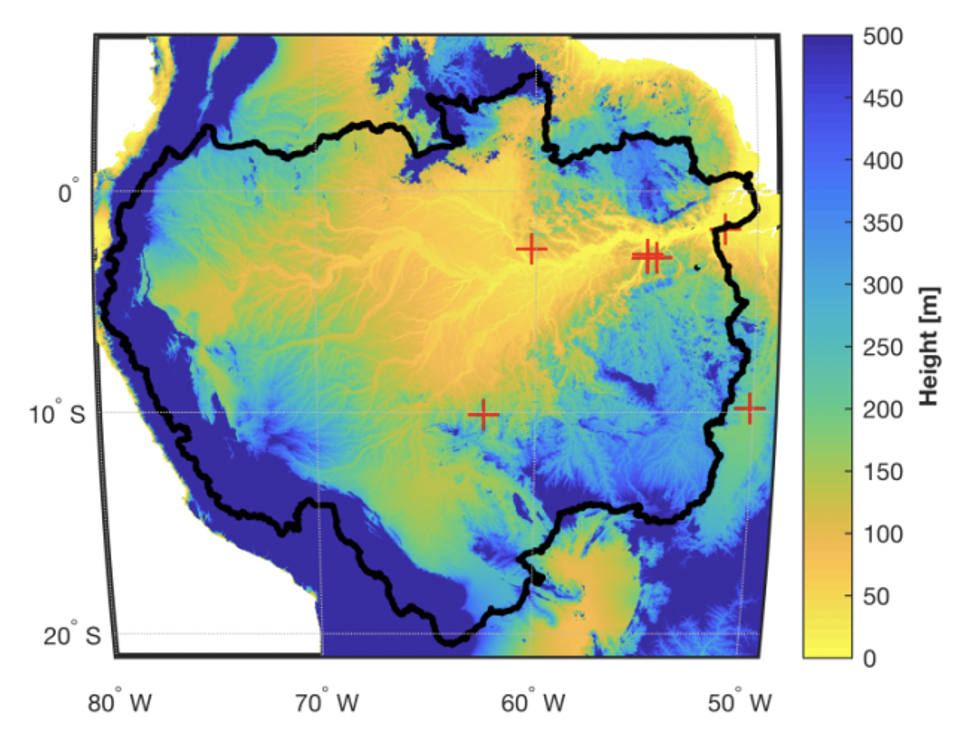Research Projects

Representation of Roots in Models
Mechanistic representation of root system structure and function is an enormous opportunity for terrestrial biosphere models. For terrestrial water cycling, where as much as two-thirds of water returns to the atmosphere through the vegetative water pathway, the interface of the soil water supply and the plant system is critical for predicting plant responses to water limitation and drought.
PFLOTRAN-Root is a modified version of the PFLOTRAN reactive transport model which simulates three-dimensional root water uptake using the Couvreur macroscale hybridization technique. It has been applied to temperate and tropical forest systems to simulate individual water uptake for upwards of 1000 trees.
Agee, E., He L., Bisht, G., Couvreur, V., Shahbaz, P., Meunier, F., Gough, C.M., Matheny, A.M., Bohrer, G., and Ivanov, V.Y. Root lateral interactions drive water uptake patterns under water limitation. 2021. Advances in Water Resources. doi.org/10.1016/j.advwatres.2021.103896
Bisht, G., Agee, E., He., L., Couvreur, V. and V.Y. Ivanov. PFLOTRAN-Root: a three-dimensional model of soil water physics and root water uptake. 2019. laagee/pflotran-dev-root-system: PFLOTRANRoot v0.0 (Version v0.0). Zenodo. doi.org/10.5281/zenodo.3540881

Quantifying Root Traits
Data from our below-ground systems is severely lagging behind our above-ground system. While some great resources exist (check out FRED – it’s awesome!), more work needs to be done, especially for biodiverse systems like the tropics. Previously, I participated with the Tropical Root Trait Initiative to help gather together published and unpublished root trait data for tropical systems so we can use it pose research questions, test hypotheses, and generate knowledge needed for our next generation of below-ground models.
Cusack, D.F., Addo-Danso, S.D., Agee, E.A., Andersen, K.M., Arnaud, M., Batterman, S.A., Brearley, F.Q., Ciochina, M.I., Cordeiro, A.L., Dallstream, C. and Diaz-Toribio, M.H., 2021. Tradeoffs and synergies in tropical forest root traits and dynamics for nutrient and water acquisition: field and modeling advances. Frontiers in Forests and Global Change, p.161. doi.org/10.3389/ffgc.2021.704469
This tree in the FLONA Tapajós (Brazilian Amazon) has grown and is beginning to eat the sensor.
Brazilian Amazon
During my graduate studies in the HydroWit lab, I helped build and deploy various networks of sensors to quantify water fluxes and stress in trees. These sensors, paired with concurrent below-ground observations, help give insights into the links between above-ground water demands and below-ground water supplies. You can read more about our work in the Brazilian Amazon in the press stories below and in future publications.
“Solve for Life.” Re-engineering Radio and Michigan Engineering. Story: Gabriel Cherry. Photos: Joseph Xu. 2019. podcast, article
“Hands-on in the Amazon.” Michigan Engineering. Story: Gabriel Cherry. Photos: Joseph Xu. July 2019. article
University of Michigan Biological Station
Check out the FoRTE data package available in R!
Atkins J.W., Agee, E., Barry, A., Dahlin, K.M., Dorheim, K., Haber, L.T., Hickey, L.J., Grigri, M.S., Mathes, K., McQuigan, C., Paris, E., Pennington, S.C., Rodriguez, C., Shafer, A., Shiklomanov, A., Tallant, J., Gough, C.M., and Bond-Lamberty, B. The fortedata R package: open-science datasets from a manipulative experiment testing forest resilience. 2020. Earth System Science Data. https://doi.org/10.5194/essd-13-943-2021.
Gough, C.M., Atkins, J.W., Bond-Lamberty, B., Agee, E., Dorheim, K., Fahey, R., Grigri, M., Haber, L., Mathes, K., Pennington, S., Schiklomanov, A., Tallant, J. Diversity, structure and complexity as predictors of carbon cycling resistance to disturbance. 2020. Ecosystems; 24(3). https://doi.org/10.1007/s10021-020-00544-1.

Remotely-sensed Evapotranspiration
As a NASA Earth and Space Science Fellow, I used data from the Geostationary Operational Environmental Satellite (GOES) to estimate long-term hourly evapotranspiration for the entire Amazon River Basin using the Maximum Entropy Production model (MEP). Despite using fewer parameters than the gold-standard Penman-Monteith evapotranspiration models, our results show that the MEP method improves estimates of ET for tropical regions like the Amazon rainforests where cloud cover and dense vegetation increase observational uncertainty.
Xu, D., Agee, E., Wang, J., and Ivanov,V.Y. Estimation of Evapotranspiration of Amazon rainforest with Maximum Entropy Production Theory. 2019. Geophysical Research Letters. doi: 10.1029/2018GL080907 Top 10% Downloaded